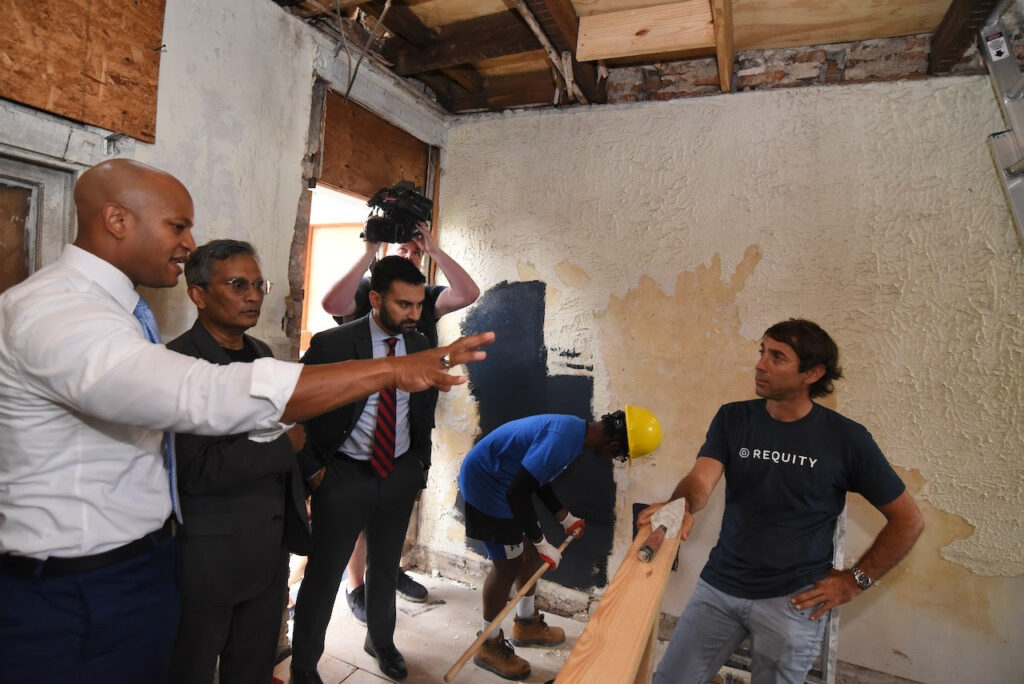Gov. Wes Moore (D) and White House National Climate Advisor Ali Zaidi tour the Requity Foundation’s Carver House workforce development project in West Baltimore in this file photo from June 2023. Photo courtesy the Governor’s Office.
The state needs to be “smarter” about how it funds workforce development programs after a $4.7 million cut in federal funds this year with more cuts expected next year, Maryland Labor Secretary Portia Wu told lawmakers Tuesday.
“We’re very dependent on the federal funds,” Wu told a virtual meeting of the Joint Audit and Evaluation Committee. “So we are in a situation where state investments in workforce are going to be critical in the coming years.”
Her comments came as the committee reviewed a handful of programs identified by the Office of Program Evaluation and Government Accountability as areas where the state can be more efficient and effective with state and federal dollars. The programs were part of a March report by OPEGA after its recent overview of all state workforce programs.
Victoria Hall, one of the OPEGA evaluators, noted that while there are some state programs supporting workforce development, a majority of funds come from the federal Workforce Innovation and Opportunity Act. She also said that the state has largely shaped its workforce development efforts to meet federal requirements.
Wu said that the state “experienced a $4.7 million cut in our federal WIOA formula funds” this year because Maryland’s unemployment rate is so low. Maryland’s jobless rate in August was 2.9%, tied with four other states for 10th-lowest in the nation, according to the Bureau of Labor Statistics.
“The formula funds are based on relative unemployment, and of course, Maryland’s unemployment has been at a record low. So it means, compared to other states, we got a smaller share of the formula this year,” Wu said. “That will be true next year as well.”
The cut was only small share of federal funding to the state. The OPEGA report shows that in 2023, federal agencies sent Maryland a total of more than $160 million for various workforce development programs.
“Also, I will note, we used ARPA funds … those funds are going to be expiring,” she said, referring to the American Rescue Plan Act, which sent federal funds to states to help recover from the fallout of the COVID-19 pandemic. Those funds are set to expire at the end of the year, and Maryland will no longer have access to those dollars that, in part, helped fund workforce development programs.
“So that’s really concerning because, as what was highlighted by the analysts, we’re very dependent on the federal funds,” Wu said.
Wu noted that the push to increase workforce education efforts is not only to provide job pathways into crucial fields such as cybersecurity and health care, but it is also a major goal of the Blueprint for Maryland’s Future, the state’s massive education reform plan.
As part of its evaluation of the state’s workforce development programs, the OPEGA report found that Maryland “lacks the infrastructure necessary to achieve the statutory goal of 45% of graduating seniors completing the high school level of a registered apprenticeship or an industry-recognized credential by the 2030-2031 school year.” That is just one of many goals in the Blueprint.
Part of the issue is that many apprenticeship opportunities require participants to be over the age of 18, automatically cutting out a majority of high-school students. The state only has one apprenticeship program for youths, called the Apprenticeship Maryland Program. In the 2021-2022 school year, it enrolled just 186 kids, well below the 23,200 students needed to meet the state’s goal in 2030, OPEGA notes. Another issue is the lack of interest from employers to take on young apprentices.
Wu believes education and workforce development “need to be hand-in-glove.”
“Especially with the many ambitious goals set forth in the Blueprint,” Wu said. “That is a huge part of that vision, is that we are educating our young people while we are training them for the jobs of today and tomorrow.”
Wu said her department has been looking at ways of “investing more, but also investing smarter” in workforce development. Options include focusing more on youth apprenticeships, tackling social barriers that hinder people from entering the workforce, and consolidating similar programs at the state and local level to streamline workforce development efforts.
After the meeting, Del. Jared Solomon (D-Montgomery) said that state efforts supporting workplace development is “the best return on money that we can get.”
“Having somebody who has a job, has long-term employability, is not only better for the long-term fiscal situation of the state and not having to provide all of the wrap-around support services that goes to somebody who is unemployed,” said Solomon, co-chair of the committee. “If we’re looking at an economy that has stagnated, then these are the places we should be putting money in.”

